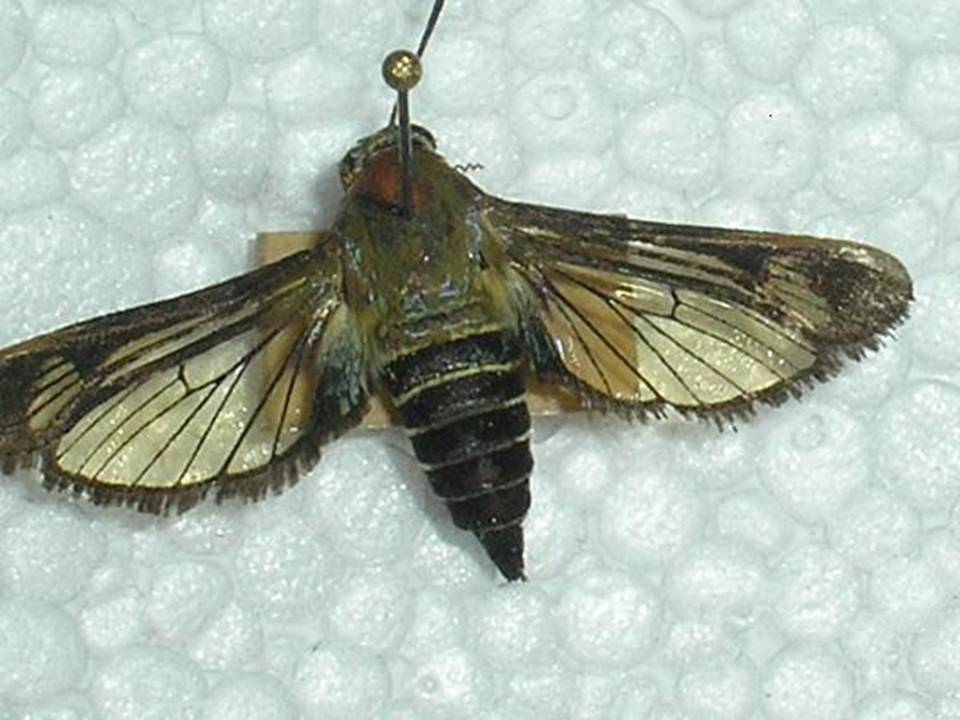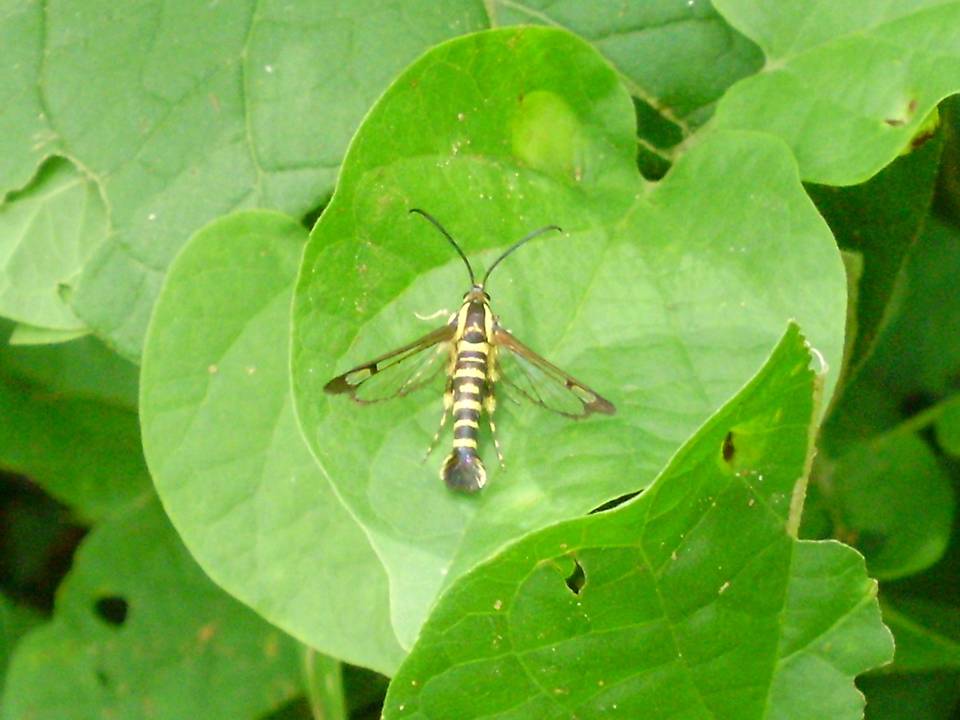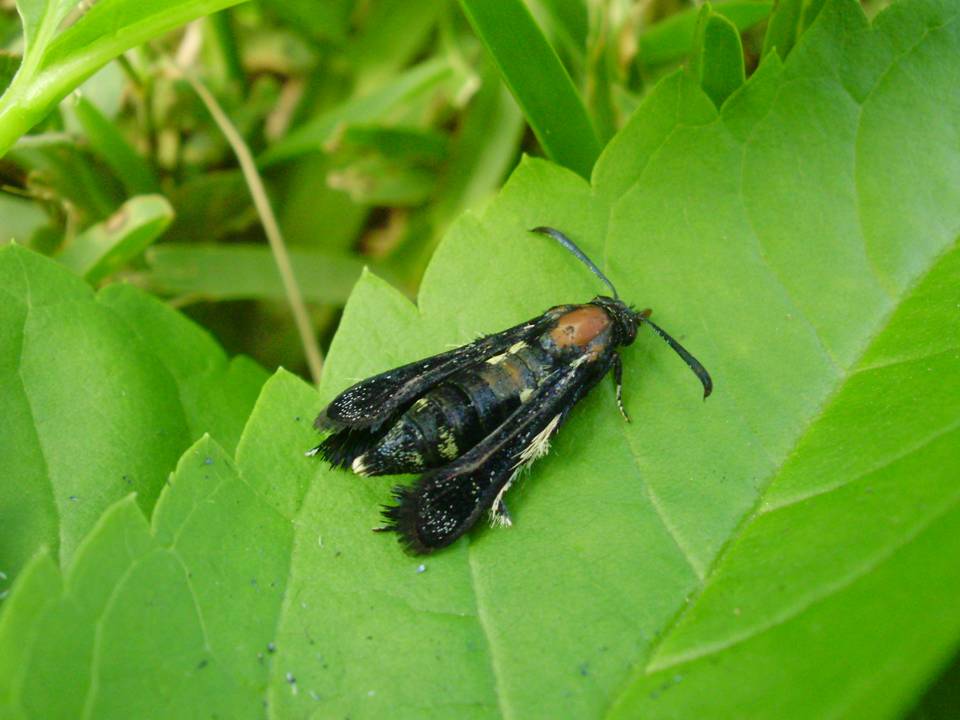

SESIIDAE - CLEARWING MOTHS
The Clearwings are a distinctive group of day-flying moths as likely to be mistaken for wasps as recognised as Lepidoptera. In fact many species are active mimics of Hymenoptera and the resemblance can be startling. Typically the wings are hyaline and the abdomen banded, and in most cases they are boldly-coloured. The family is distributed worldwide with about 1000 species described, reaching their greatest diversity in tropical regions.
Click on the photo to enlarge it to full size.
Characteristics
Clearwings have scales appressed to the surface of the head and large external ocelli. Antennae may be filiform, pectinate or bipectinate, though they are frequently swollen towards their apices, forming a setose tip. Proboscis lacks scaling at the base and occasionally is reduced. Maxillary palps are tiny (1 to 3 segments) and labial palps are upcurved. Tibial spur formula 0-2-4 and epiphysis is present, tufts of scales sometimes present where tibial spurs arise. Forwings elongate and narrow, especially at the base and at least partially hyaline (though rarely fully scaled). In forewing veins R4 and R5 arise from a long stalk, CuP is absent and 1A + 2A is short, lying in a longitudinal fold in the wing. Hindwing is broader than the forewing. Veins Sc + R1 and Rs are parallel and close together in a costal fold. Vein M3 and CuA1 are stalked. A1 of the anal veins is usually barely visible, indicated by a line of scales, A2 is conspicuous and A3 and A4 are short but distinct. There is a frenulum-retinacular wing coupling system and in addition the anal area of the forewing folds downwards to interlock with an upturned costal fold on the hindwing. A forewing metathoracic locking device is present. Abdomen tapers posteriorly and may be narrowed basally. Ovipositor may be extensile or non-extensile. Wing transparency has arisen separately in various branches of the family and may be achieved by loss of deciduous scales shortly after emergence, presence of transparent scales or a complete absence of scales. (Scoble 1995).
Life Cycles
Eggs are generally laid in crevices on the foodplant but may be dropped on the ground nearby. Larvae are generally borers in tree trunks, branches or roots or occasionally in stems of herbaceous plants or even galls. Cocoons are formed in some species and pupation usually occurs within the tunnel constructed in the food plant. The larvae is hypognathous or slightly prognathous. Prolegs are reduced, though a full complement is present. In the pupa a double row of dorsal spines is present (on A2-A7 in males and A2-A6 in females) with a single row on A8-A10. The pupa protrudes from the larval tunnel prior to emergence. There is no distinct cremaster. (Scoble 1995).
Classification
The Sesiidae are classified into three subfamilies.
Paranthreninae - This assemblage may represent an unnatural grouping of unspecialised Sesiids and is by far the largest subfamily. Its monophyly has not been satisfactorily proven.
Sesiinae - Possesses the greatest number of derived characters such as a fused uncus and tegumen in the male genitalia.
Tinthiinae - Primitive with antennae not swollen distally and which mat be pectinate, bipectinate or filiform. Males lack a gnathos in their genitalia.
Superfamily Sesioidea: Family Sesiidae.
Designed by Paul Smith 2006.
This website is copyrighted by law. Material contained herewith may not be used without the prior written permission of FAUNA Paraguay.
Photographs on this page were taken by Sergio Rios and Andres Contreras and are used with their permission.
 | FIGURE 1 |
|
 | FIGURE 2 |
|
 | FIGURE 3 |
|
FIGURE 1 - Unidentified sp - Pilar, Departamento Ñeembucú (Andres Contreras 2010).
FIGURE 2 - Carmenta sp - Asunción, Departamento Central (Sergio Rios January 2011).
FIGURE 3 - Melittia sp - Asunción, Departamento Central (Sergio Rios January 2011).

